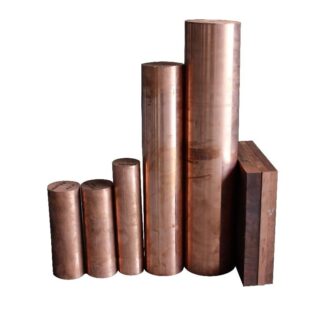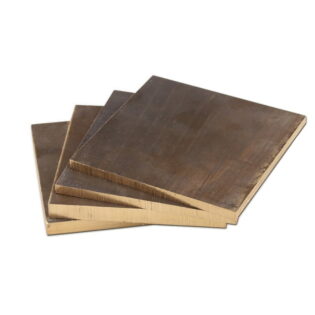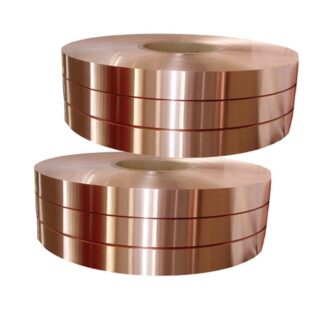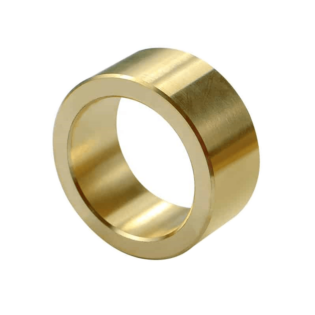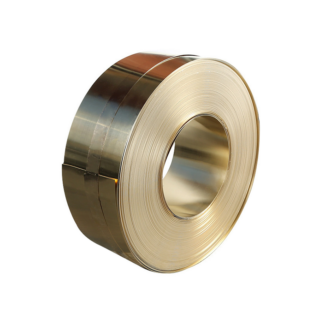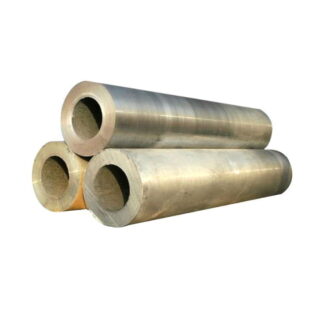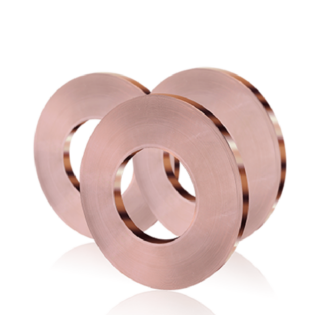Introducción del producto:
C90810 High Tin Bronze is a copper-based alloy known for its exceptional strength, wear resistance, and corrosion resistance. This alloy is particularly valued in applications requiring high load-bearing capacity and low-speed operations. The high tin content contributes to its superior mechanical properties, making it an ideal choice for various industrial applications.
Chemical Composition of C90810
| Elemento | Porcentaje (%) | Función |
|---|
| Con | Recordatorio | Metal base, proporciona ductilidad y conductividad. |
| Sn | 11.00-13.00 | Improves strength, hardness, and wear resistance |
| Pb | 0.25 máx. | Enhances machinability |
| Zn | 0.30 máx. | Improves fluidity in casting |
| Fe | 0.15 máx. | Refinador de granos, aumenta la fuerza. |
| PAG | 0.15-0.80 | Desoxidante, mejora la fluidez. |
| Ni | 0.50 máx. | Increases strength and corrosion resistance |
| Alabama | 0.005 máx. | Desoxidante |
| S | 00,05 máx. | Mejora la maquinabilidad |
| Sb | 0.20 máx. | Increases hardness |
| Y | 0.005 máx. | Desoxidante |
Notas:
- In determining Cu min., Cu may be calculated as Cu + Ni.
- For continuous castings, P shall be 1.5% max.
- El valor Ni incluye Co.
- Cu + sum of named elements, 99.4% min. Single values represent maximums.
Mechanical Properties of C90810
| Propiedad | Valor | Unidad |
|---|
| Brinell Hardness (500 Kg load) | 95 typical | Resistencia a la tracción de |
| Clasificación de maquinabilidad | 20 | - |
| Densidad | 0.323 | lb/in³ at 68 °F (20 °C) |
| Fuerza de Tensión | 40,000 | psi |
| Fuerza de producción | 20,000 | psi |
| Alargamiento | 20 | % |
| Módulo de elasticidad | 15 | x 10^6 psi |
Rendimiento a diferentes temperaturas
| Rango de temperatura | Características de presentación | Recommended Use |
|---|
| Baja temperatura (-50°C a 0°C) | Maintains ductility and toughness | Suitable |
| Temperatura ambiente (20°C a 25°C) | Optimal strength and wear resistance | Ideal |
| Elevated Temperature (100°C to 200°C) | Retains strength but may experience slight softening | Acceptable |
| High Temperature (>200°C) | Not recommended for prolonged use | No recomendado |
Aplicaciones industriales
| Industria | Aplicaciones | Beneficios clave |
|---|
| Maquinaria industrial | Bearings, gears, shafts, worm gears | Alta resistencia al desgaste |
| Marina | Impulsores de bombeo, cuerpos de válvulas | Resistencia a la corrosión |
| Construcción | Componentes de puente móvil, plideres para puentes | Strength and durability |
| Automotor | Piston rings | Bajo coeficiente de fricción |
| Energía | Steam fittings | Heat resistance |
| Minería | Heavy-duty bushings | Impact resistance |
| Aeroespacial | Bushings for landing gear | High load capacity |
| Petróleo y gas | Componentes de válvulas | Corrosion resistance in harsh environments |
Disponibilidad de formas y tamaños
| Forma | Rango de tamaño | Longitud estándar |
|---|
| Sólidos | 1″ to 6″ O.D. | 144″ |
| estado de entrega | 1″ to 6″ O.D. | 144″ |
| Rectángulos | Up to 10″ | 144″ |
| S45c | Up to 24″ thickness | 96″ x 240″ |
| Rods | 0.25″ to 12″ diameter | 144″ |
| Custom Shapes | As per requirement | Varies |
Available Forms
| Formulario | Typical Use | Disponibilidad |
|---|
| Semi-finished | Further processing | Common |
| Mill stock | Direct use | Widely available |
| Near-net shapes | Minimal machining | On request |
| Bar stock | Mecanizado | Estándar |
| Plato | Large flat components | Common |
| Profile or structural shape | Specific applications | On request |
| Forjas | Componentes de alta resistencia | Limitado |
| Piezas fundidas | Complex shapes | Common |
Production Standards and Compliance
| Standard/Compliance | Región | Relevance |
|---|
| Federal Safe Drinking Water Act – SDWA | Estados Unidos | Water safety |
| S. 3874 Ley Federal de Reducción del Plomo en el Agua Potable | Estados Unidos | Lead content |
| CaliforniaAB1953 | California, USA | Lead content |
| Ley 193 de Vermont | Vermont, USA | Lead content |
| ASTM B505 | Internacional | Continuous Casting of Copper Alloys |
| ASTM B271 | Internacional | Copper-Base Alloy Centrifugal Castings |
| ISO 1338 | Internacional | Cast copper alloys |
| JIS H5111 | Japón | Bronze castings |
Estándares y grados correspondientes en diferentes países
| País | Estándar | Grado correspondiente |
|---|
| Estados Unidos | nosotros | C90810 |
| Alemania | DE | CUSN12 |
| Japón | JIS | CAC704 |
| United Kingdom | BS | HTB1 |
| Francia | NF | CUSN12 |
| Italia | UNI | CUSN12 |
| Rusia | GOST | BrO12 |
| porcelana | GB | ZCUSN12 |
| Internacional | YO ASI | CUSN12 |
Características de soldadura
| Método de soldadura | Idoneidad | Notas | Preheat Temp |
|---|
| Gas Welding | Bien | Use phosphor bronze filler rod | 150-200°C |
| TIG Welding | Excelente | Use pure argon shielding gas | Según sea necesario |
| MIG Welding | Bien | Use bronze filler wire | Según sea necesario |
| Stick Welding | Justo | Use bronze electrodes | Según sea necesario |
| Soldadura por resistencia | Pobre | No recomendado | N / A |
| Soldadura por haz de electrones | Bien | For precision applications | Según sea necesario |
| Soldadura por láser | Justo | Requires careful control | Según sea necesario |
Características de procesamiento
| Proceso | Idoneidad | Notas | Key Consideration |
|---|
| Mecanizado | Bien | Machinability rating of 20 | Tool selection |
| Formando | Justo | Formabilidad limitada debido al alto contenido de estaño | Avoid excessive deformation |
| Forjar | Pobre | No recomendado | N / A |
| Fundición | Excelente | Ideal for sand and centrifugal casting | Proper cooling rate |
| Extrusión | Pobre | Not typically extruded | N / A |
| Deep Drawing | Pobre | Limited ductility | No recomendado |
| Spinning | Justo | Possible with proper techniques | Avoid work hardening |
| Broaching | Bien | Suitable for precision sizing | Tool wear |
Polishing Characteristics
| Método de pulido | Result | Recommended Abrasives |
|---|
| Pulido mecánico | Good surface finish achievable | Alumina or diamond compounds |
| Pulido químico | Moderate results | Proprietary solutions |
| electropulido | Excellent for high luster finish | Phosphoric acid-based electrolytes |
| Pulido | High shine possible | Soft cloth wheels with fine abrasive |
| Lapping | Precision finish | Diamond or silicon carbide compounds |
| Honing | Good for cylindrical surfaces | Bonded abrasive stones |
Tratamiento térmico
| Tratamiento térmico | Rango de temperatura | Objetivo | Método de enfriamiento |
|---|
| Recocido | 550-650°C | Stress relief and softening | Slow cooling |
| Tratamiento de solución | No aplicable | C90810 is not heat treatable | N / A |
| Endurecimiento de la edad | No aplicable | C90810 is not age hardenable | N / A |
| Aliviar el estrés | 260-370°C | Reducir las tensiones internas | Aire acondicionado |
| Normalizando | Not typically performed | N / A | N / A |
| Temple | No recomendado | May cause distortion | N / A |
Cold Processing Characteristics
| Proceso | Idoneidad | Notas | Alternative Suggestion |
|---|
| Trabajo en frío | Limitado | High tin content reduces ductility | Consider hot working if necessary |
| Dibujo en frío | Pobre | No recomendado | Use machining instead |
| Laminado en frío | Pobre | No recomendado | Consider cast or machined forms |
| Cold Heading | No apto | Too brittle | Use machining or casting |
| Forja en frio | No apto | Lacks necessary ductility | Consider hot forging or casting |
| Granallado | Justo | Can improve surface properties | Use with caution |
Advantages and Disadvantages of C90810
| Ventajas | Desventajas | Consideraciones |
|---|
| Alta resistencia | Formabilidad limitada | Design for minimal forming |
| Excelente resistencia al desgaste | Higher cost compared to some bronzes | Consider for critical applications |
| Buena resistencia a la corrosión | No apto para aplicaciones de alta velocidad | Use in low to moderate speed settings |
| Bajo coeficiente de fricción | Capacidad limitada para trabajar en frío. | Design for as-cast or machined forms |
| Adecuado para cargas pesadas | Not heat treatable | Select for applications not requiring heat treatment |
| Buena maquinabilidad | Relatively high density | Consider weight in design |
| Excellent bearing properties | Susceptible to tin pest at very low temperatures | Avoid prolonged exposure below 13°C |
| Buena estabilidad dimensional | Can be difficult to weld | Use appropriate welding techniques |
| Resistant to seawater corrosion | Not as strong as steel | Use in appropriate load conditions |
| Low magnetic permeability | Higher cost than brass | Justify cost with performance requirements |
Productos similares
| Aleación | Número UNS | Main Composition | Diferencias clave |
|---|
| C90700 | C90700 | Cus-sn-zn | Lower tin, higher zinc content |
| C91100 | C91100 | Cu-Sn | Higher tin content, no lead |
| C93200 | C93200 | Cu-Sn-Pb | Higher lead content for improved machinability |
| C95400 | C95400 | Con | Aluminum bronze with different property profile |
| C95500 | C95500 | Cu-Al-Ni-Fe | Nickel-aluminum bronze with higher strength |
| C86300 | C86300 | Cu-Mn-Ni-Fe | Manganese bronze with higher strength |
| C92200 | C92200 | CU-SN-PB-ZN | Navy M gun metal with different composition |
Comparison of C90810 with Similar Products
| Propiedad | C90810 | C90700 | C91100 | C93200 | C95400 |
|---|
| Tensile Strength (psi) | 40,000 | 36,000 | 45,000 | 35,000 | 90,000 |
| Yield Strength (psi) | 20,000 | 18,000 | 25,000 | 18,000 | 45,000 |
| Elongación (%) | 20 | 25 | 15 | 20 | 15 |
| Resistencia a la tracción de | 95 | 70 | 100 | sesenta y cinco | 190 |
| Resistencia a la corrosión | Excelente | Bien | Excelente | Bien | Excelente |
| Maquinabilidad | Bien | Muy bien | Justo | Excelente | Justo |
| Soldabilidad | Justo | Bien | Justo | Pobre | Bien |
| Resistencia al desgaste | Excelente | Bien | Excelente | Bien | Excelente |
| Costo | Alto | Moderado | muy alto | Moderado | Alto |
| Aplicaciones Típicas | Rodamientos de servicio pesado | General-purpose | High-load bearings | Bujes, rodamientos | Marine components |
Conclusión:
C90810 High Tin Bronze is a specialized alloy that offers a unique combination of properties, making it invaluable in various industrial applications. Its high tin content contributes to excellent strength, wear resistance, and corrosion resistance, particularly in heavy-load, low-speed settings. While it has limitations in formability and high-temperature applications, C90810 excels in industries such as marine engineering, industrial machinery, and construction.
The alloy’s versatility is evident in its wide range of available forms and sizes, adherence to international standards, and good machinability. However, designers and engineers must consider its specific characteristics, such as limited cold working ability and heat treatment options, when incorporating C90810 into their projects.
Compared to similar alloys, C90810 stands out for its balance of strength, wear resistance, and corrosion resistance. Its unique property profile makes it an ideal choice for applications where these characteristics are crucial, justifying its higher cost in critical components.
In summary, C90810 High Tin Bronze continues to be a valuable material in modern engineering, offering reliable performance in demanding environments where other alloys may fall short.


